9 Best WebSocket Libraries for Node.js in 2024
The ability to establish communication between your browser and the servers is now possible due to WebSocket libraries. It enables you to send messages to that server and receive event-driven responses in return. Even without checking with the server for updates.
Additionally, some developers choose to use the WebSocket libraries' APIs. This is done to provide asynchronous communication between the server and your browsers. It enables you to show performance issues, address bad connections, handle authentication and authorization, and finally, scalability may require a framework or library.
In this article, we'll go over 9 Node.js WebSocket libraries that you should think about in 2023:
- WS
- SockJS
- Faye WebSocket
- Sockette
- Socket.IO
- Feathers
- SocketCluster
- WebSocket Node
- WebSocket As Promised
You must set up npm and Node.js on your local computer to begin using any of these libraries. Let's briefly examine some essential WebSockets background information before continuing.
WebSocket
Messages can also be sent and received via the WebSocket protocol. TCP (Transmission Control Protocol) is a transport-layer protocol that makes sure streams of bytes, transmitted over in packets, are delivered consistently and predictably from one computer to another.
TCP connections are used by both HTTP and WebSockets to send messages. In other words, HTTP and WebSockets both employ the same delivery mechanism at the packet/byte level, but they use separate message-structure protocols.
The client first makes an HTTP "handshake" request with an Upgrade header indicating that it wants to create a WebSocket connection with the server before connecting. The ws: or wss:: URI is where the request is sent (analogous to HTTP or https).
The server delivers a successful handshake response, denoted by HTTP status code 101 Switching Protocols if the server can establish a WebSocket connection and the connection is allowed.
While packets are still transferred via TCP after the connection is updated, the protocol changes from HTTP to WebSocket and communication now follows the WebSocket message format.
Both the client and the server can send messages at the same time due to TCP, the underlying protocol that transfers data packets. It is possible to transmit a large message without announcing its size in advance since messages might be split.
WebSockets divides it into frames in such a scenario. Each frame has a little header that lists the frame's length, a payload type, and if it's the last frame.
WebSocket connections can be opened by a server with a variety of clients, including numerous connections with the same client. Then, one, a few, or all of these clients can receive messages from it.
This essentially means that numerous users can log in to our chat app and that we can communicate with a few of them at once. Finally, either the client or the server can transmit a "close" message when it's time to end the connection.
The web-socket libraries are the most helpful and actively developed are listed in this article. Instead of spending time looking for it, it will help you save time.
#1 WS
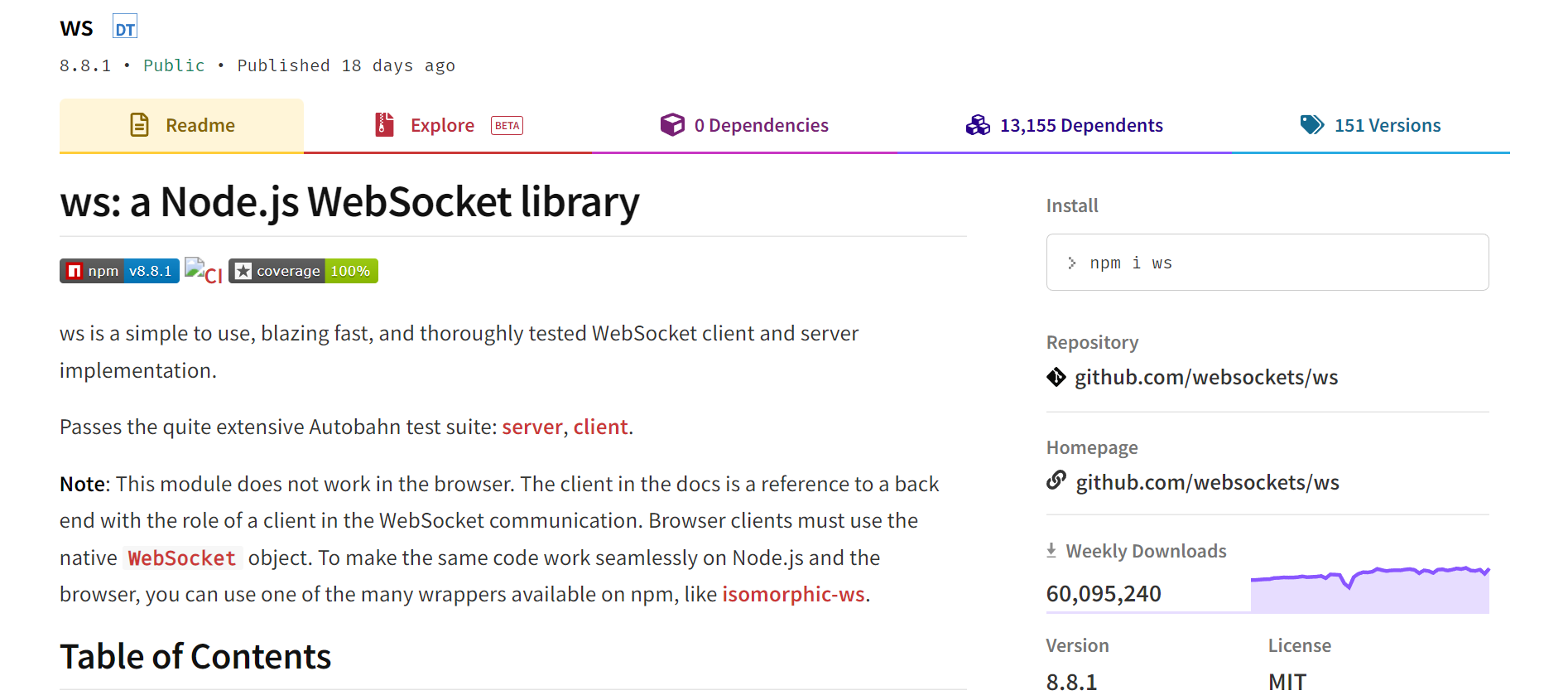
On the list of web socket libraries, WS is particularly well-liked. It has 18.5k stars. A user/server library for Node.js is called WS. It supports your management efforts while following WebSocket libraries' guidelines. Because it is very well-liked and supports nearly all browsers. This has led to individuals choosing WS over Socket.IO first and foremost.
WS is essentially a WebSocket type that is incredibly quick, simple to use, and fully tested. There are 2 additional modules that can be inserted in addition to the WS module. These supplementary modules are referred to as binary addons, and they help in enhancing particular operations.
It is no longer essential to have a C++ compiler installed on your computer because binaries that are prebuilt and accessible for the most popular systems are available.
Use one of the following commands to install ws, which is a fairly simple process:
npm install ws
// Or
npm i wsConsult the documentation to get started with the ws WebSocket library.
Using the below command, you can quickly execute tasks like masking and unmasking the data payload of WebSocket messages.
npm install --save-optional bufferutilUse the below command to quickly determine whether a message contains a valid UTF-8.
npm install --save-optional utf-8-validate#2 SockJS
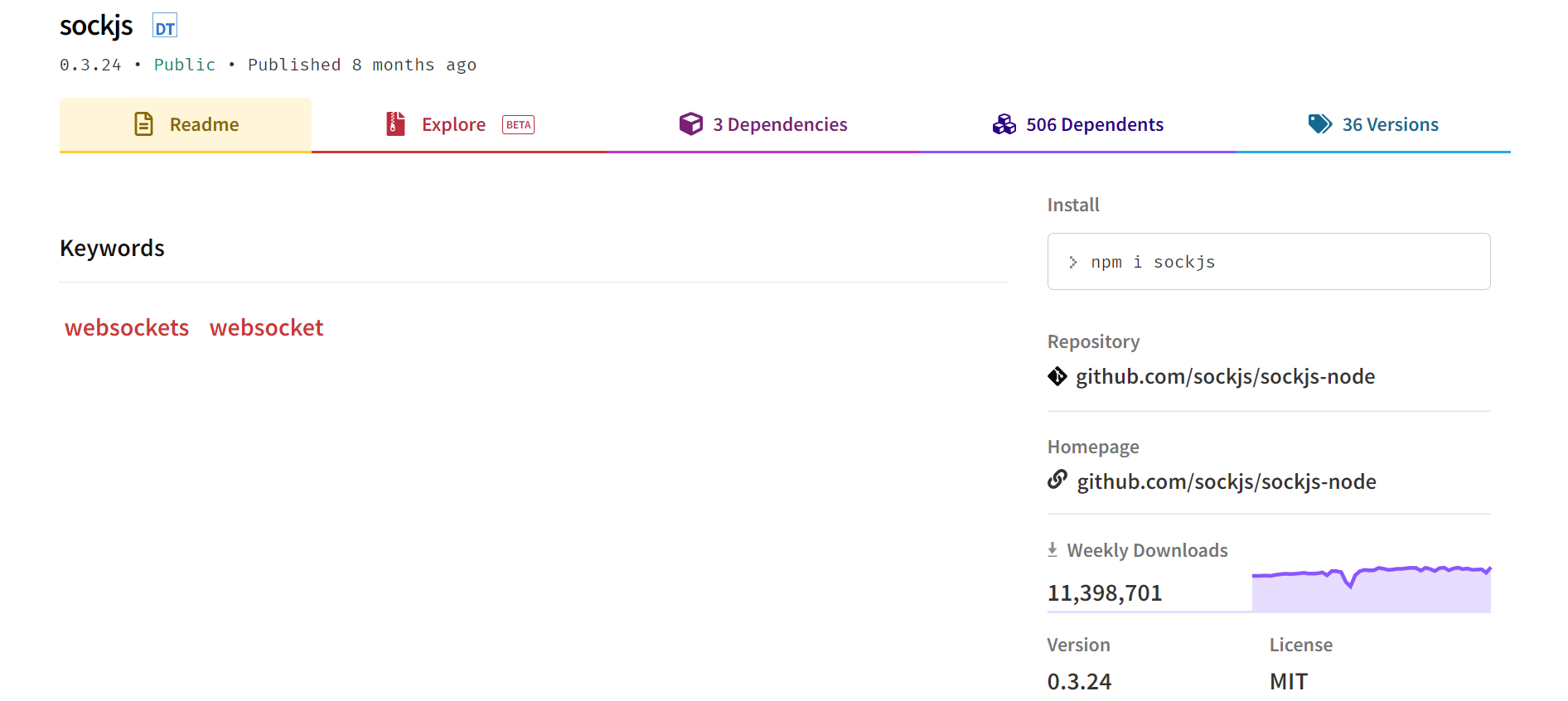
The JavaScript package SockJS (for browsers) offers an object that resembles a WebSocket. With or without WebSockets, SockJS provides you with a consistent, cross-browser Javascript API that establishes a low-latency, full-duplex, cross-domain communication channel between the browser and the web server. This requires the use of a Node.js server, of which this is one version.
SockJS is a JavaScript library that facilitates client-server communication in a manner like the native WebSockets API. SockJS works with sockjs-node, a server equivalent, and SockJS-client, a JavaScript client library.
One of the best WebSocket libraries for Node.js is undoubtedly SockJS, which has over 2k stars on GitHub and approximately 11 million weekly downloads. SockJS offers objects that are similar to WebSocket and comply with the HTML5 WebSocket API's standards.
To install sockjs-node run:
npm install --save sockjs#3 Faye WebSocket
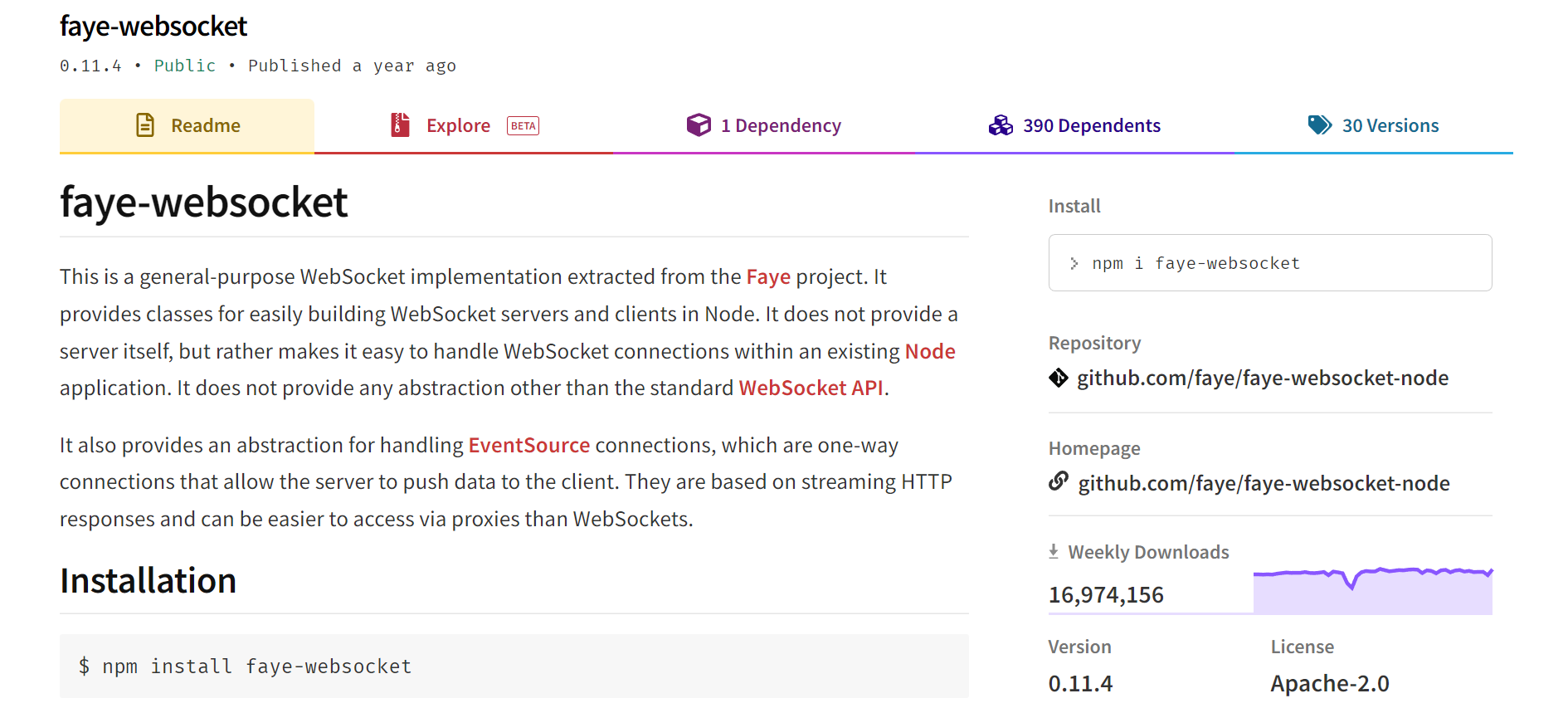
Faye WebSocket is a general-purpose WebSocket implementation and was taken from the Faye project. This gives us the classes we need to make these web socket servers and clients in the Node quickly.
It rather makes it simple to control the WebSocket connections inside of an already running Node application rather than providing anything to a server directly. In addition, it only gives us the WebSocket API as an abstraction.
However, it gives us abstraction for managing the one-way, EventSource connections that let the server provide data to the client. Instead of using WebSockets, these are based on streaming HTTP responses and are simple to access.
You can use them on an open event if you need to determine when the WebSocket handshake has been completed.
To install faye-websocket run:
npm install --save faye-websocket#4 Sockette
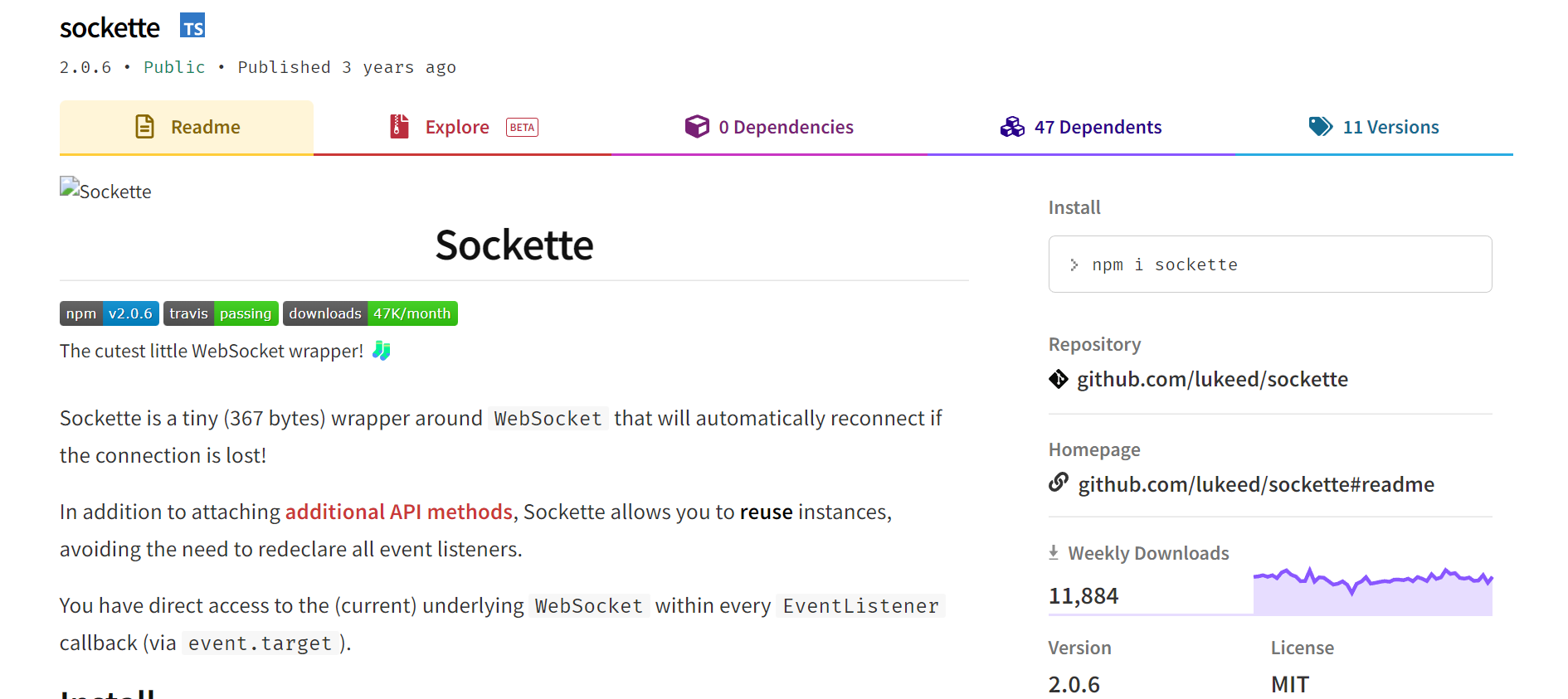
With Sockette, a WebSocket wrapper, you can reuse instances without repeatedly declaring all event listeners. Sockette is an extremely little library, weighing in at only 367 bytes, as stated on the GitHub page. Sockette will instantly re-establish any lost connections.
It is advisable to specify all event listeners at the time of initialization because Sockette is a compact tool. Run the command below to install Sockette and begin going:
npm install --save socketteSockette has about 2k stars on GitHub and 9k weekly downloads on npm as of this writing. The documentation is an excellent backup source.
#5 Socket.IO
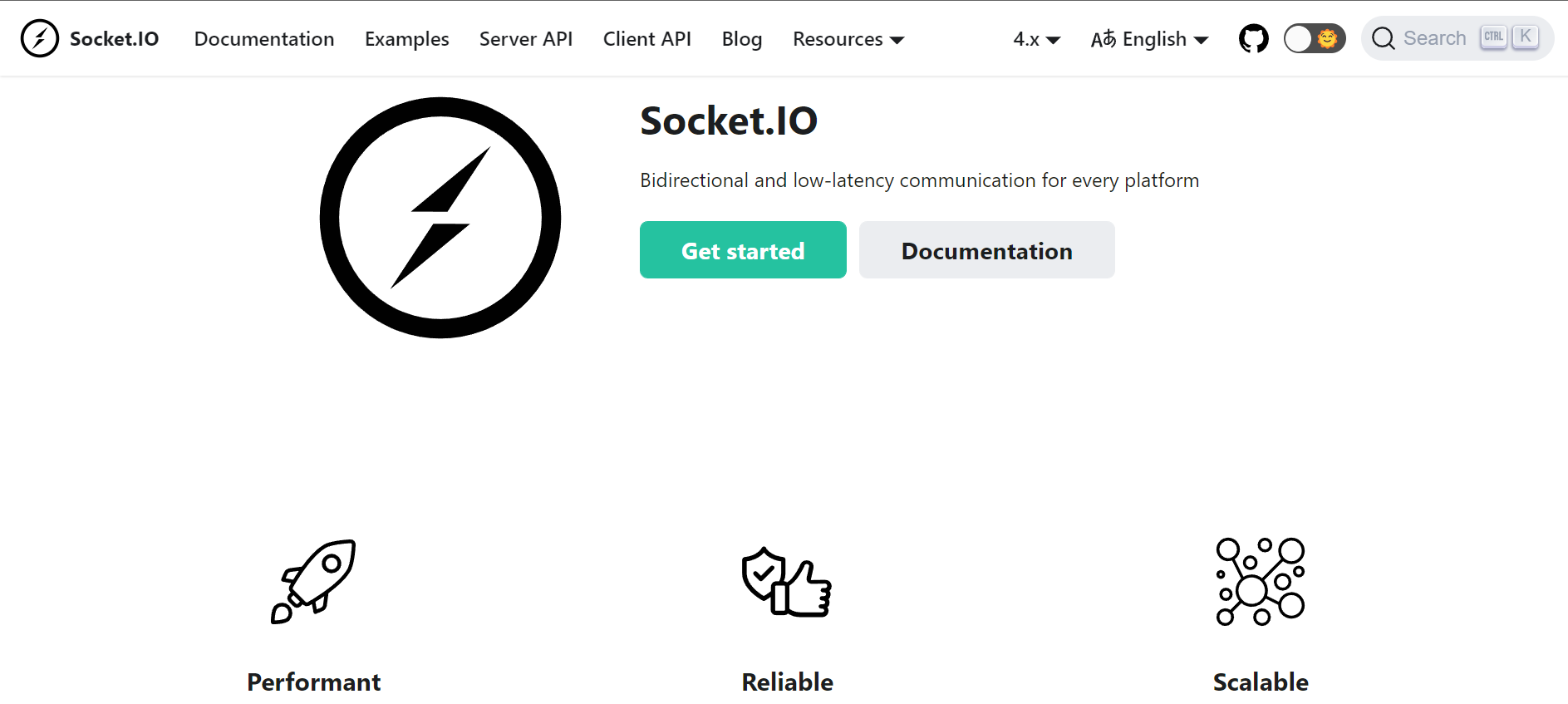
Socket.IO, a well-known WebSocket library that was founded in 2010, is utilized by several significant corporations, including Microsoft and Trello. With features like load balancing, support for binary streaming, handling proxies, and more, Socket.IO is dependable.
But real-time, bidirectional, event-based communication between the browser and the server is the main application of Socket.IO. Similar to WS, Socket.IO provides a JavaScript client library and a Node.js server.
Additionally, Socket.IO has functionality like broadcasting over a network and allowing connections made while using proxies or load balancers. These two activities are not supported by WebSocket.
Socket.IO is a great library to watch in 2023 with about 56k stars on GitHub and about 4.4 million downloads on npm weekly.
Run the command below to install socket.io:
npm install --save socket.ioAlso Read: WebSockets Tutorial: Going Real-time with Node and React.
#6 Feathers
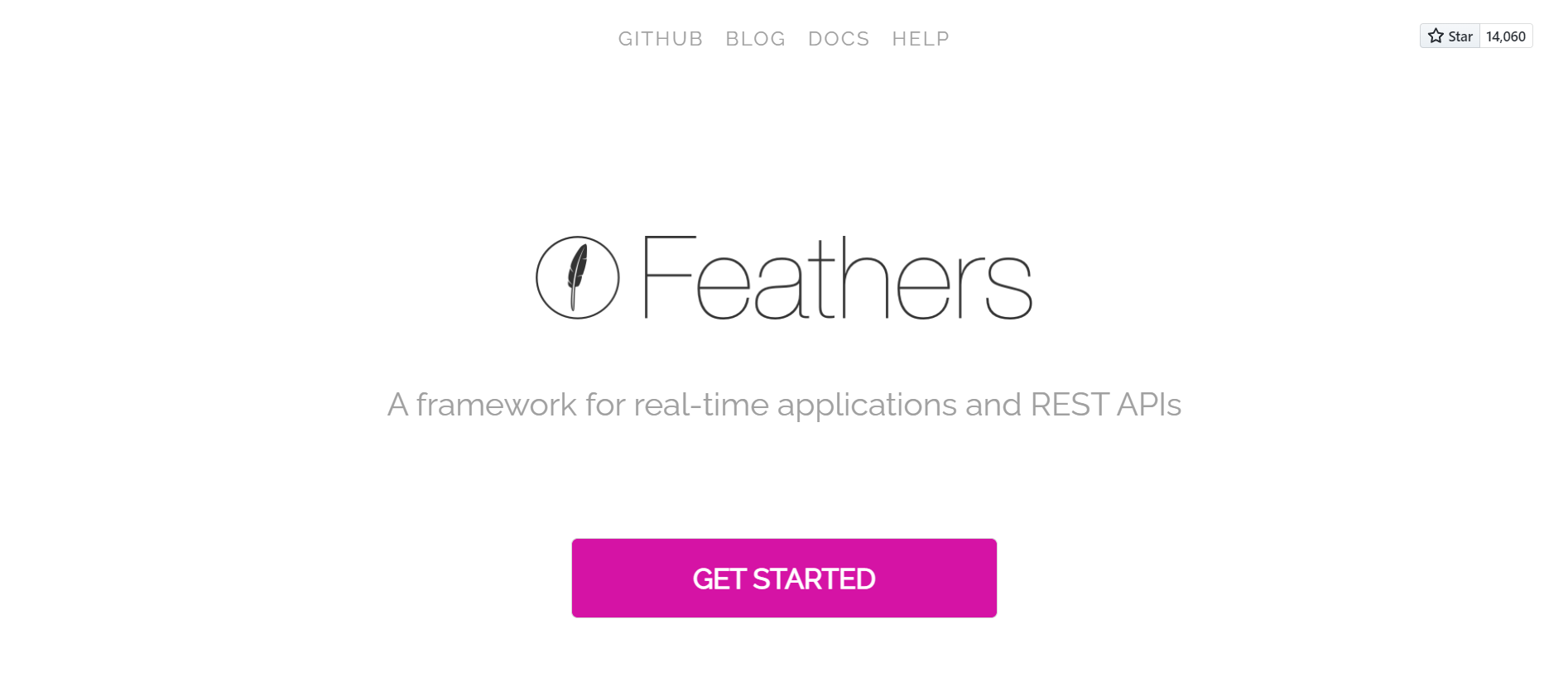
The Socket.IO module is used by the Feathers framework so that updates can be received and sent instantly. Through sockets, adaptable plugins, a RESTful API, and resources, it also provides you control over your data.
The ideal blend of automation and control is provided by feathers. Feathers allow you to take advantage of the tools while yet maintaining total control over how your API behaves.
Feathers is a real-time microservice web application framework for NodeJS. Through RESTful API, sockets (plug-in), and adaptable plugins, it offers you control over your data and enables communication and real-time changes via the Socket.IO module.
As of this writing, the project has almost 14k GitHub stars and 26k npm weekly downloads. Feathers library is known for being compact and simple to integrate with various databases, and it also comes with excellent documentation.
To install feathers run:
npm install --save feathers#7 SocketCluster
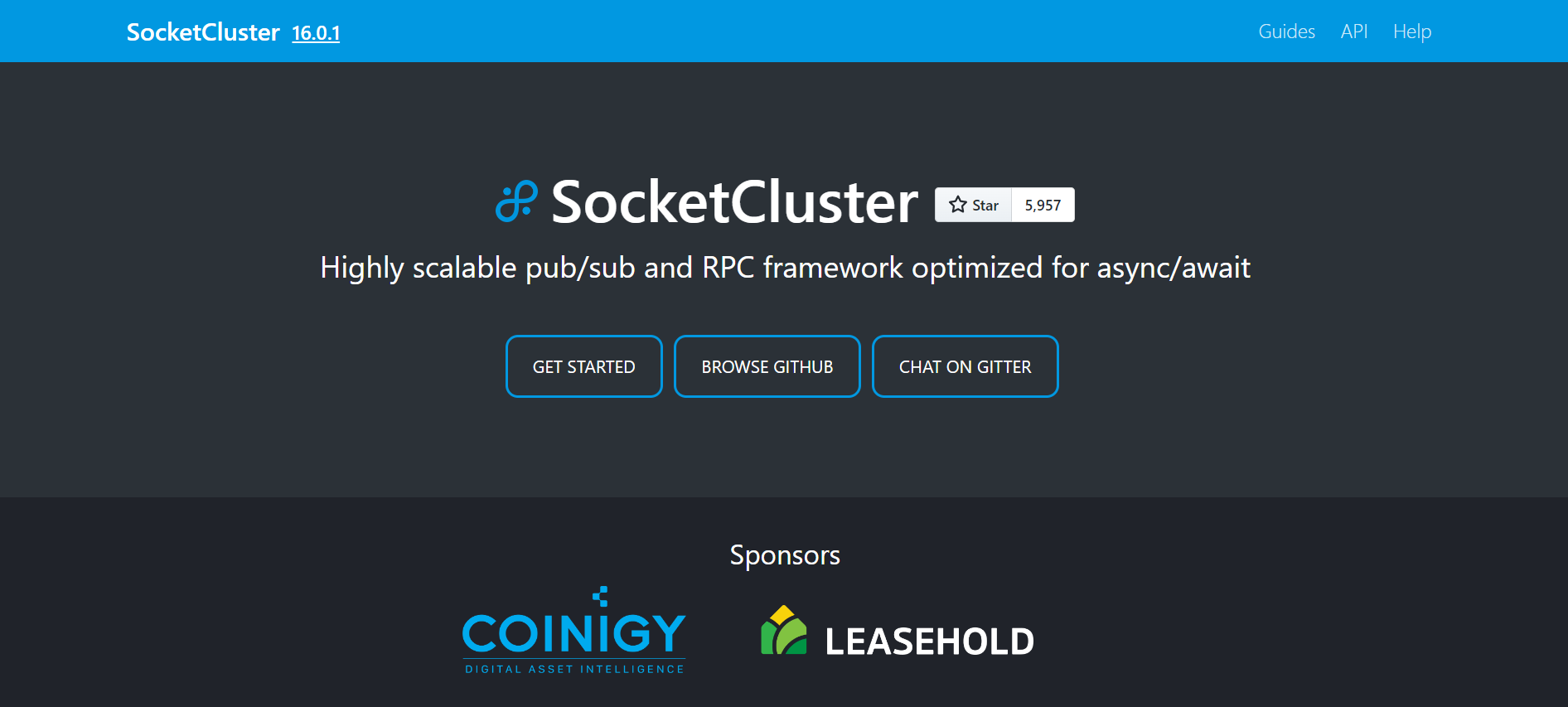
You can create multi-process, real-time servers employing all of the available CPU cores at once with the help of the highly scalable framework and real-time HTTP server engine known as SocketCluster.
SocketCluster enables the backend to operate more effectively and resiliently by preventing the Node.js server from running on a single thread.
Through pub/sub-channels, the SocketCluster framework supports client-server and group communication. It connects the cluster's parts using local area networks (LAN). SocketCluster is designed to quickly reconnect after a failure or disconnect without losing any data.
As of this writing, SocketCluster has almost 6,000 GitHub stars and 7,000 npm weekly downloads.
To install socketcluster run:
npm install --save socketcluster#8 WebSocket Node
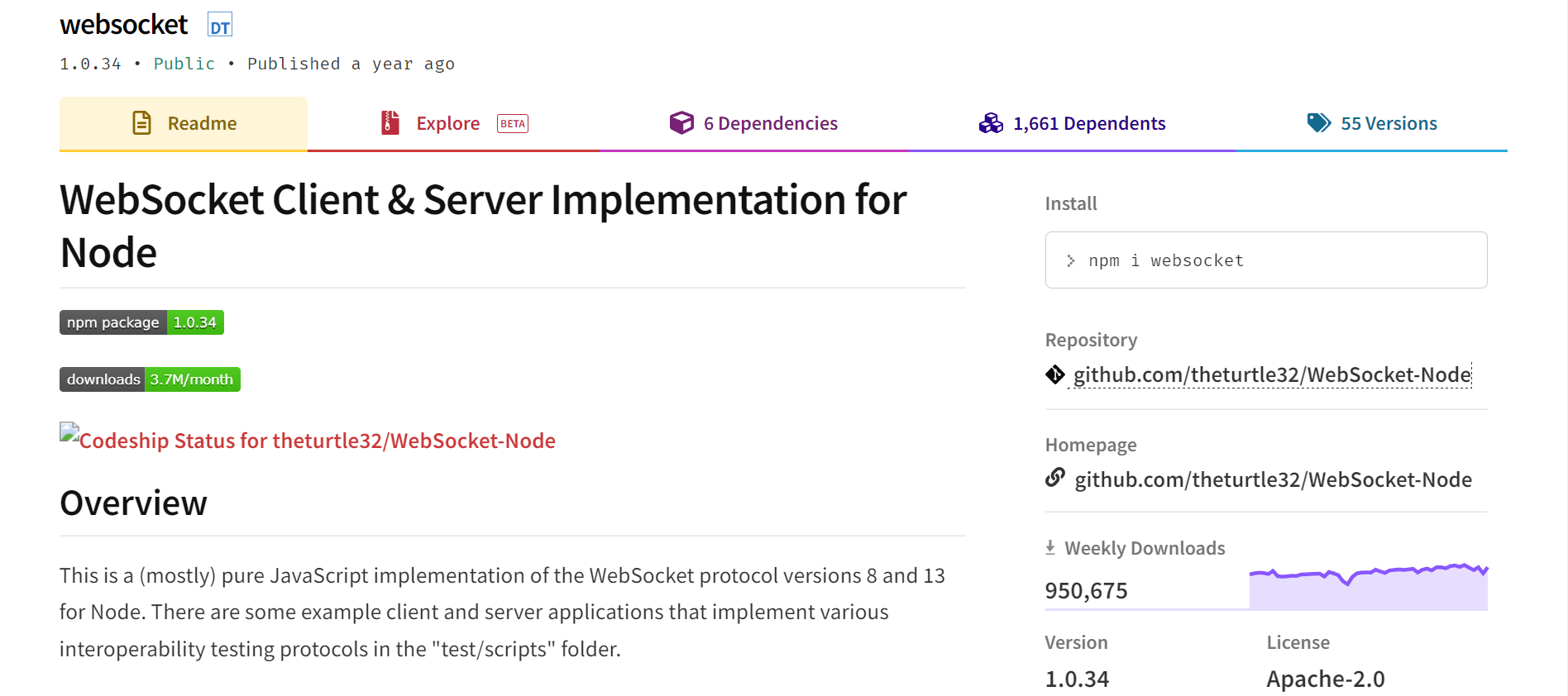
The WebSocket libraries used by node have around 2,000 stars, and their implementation is solely based on Javascript protocol versions 8 and 13.
The client and server functionality of WebSocket-Node is made available by WebSocketClient and WebSocketServer. Once the association is established, the API for sending and receiving messages is the same.
A network socket is a socket structure located inside a computer network node that serves as the endpoint for data sent and received across the network. An API determines the structure and attributes of a socket. The socket is created while a process of an application executing in a node is active.
The term network socket is widely used in the context of the internet protocol suite and is frequently referenced as an internet socket due to the standardization of the TCP/IP protocol in the evolution of the internet. The host can locate a socket outside by using its socket address, which is the trinity of the transport protocol, IP address, and port number.
The term "socket" refers to the software terminal of node-internal inter-process communication (IPC), which frequently makes use of the same API as the network socket.
To install the websocket run:
npm install --save websocket#9 WebSocket As Promised
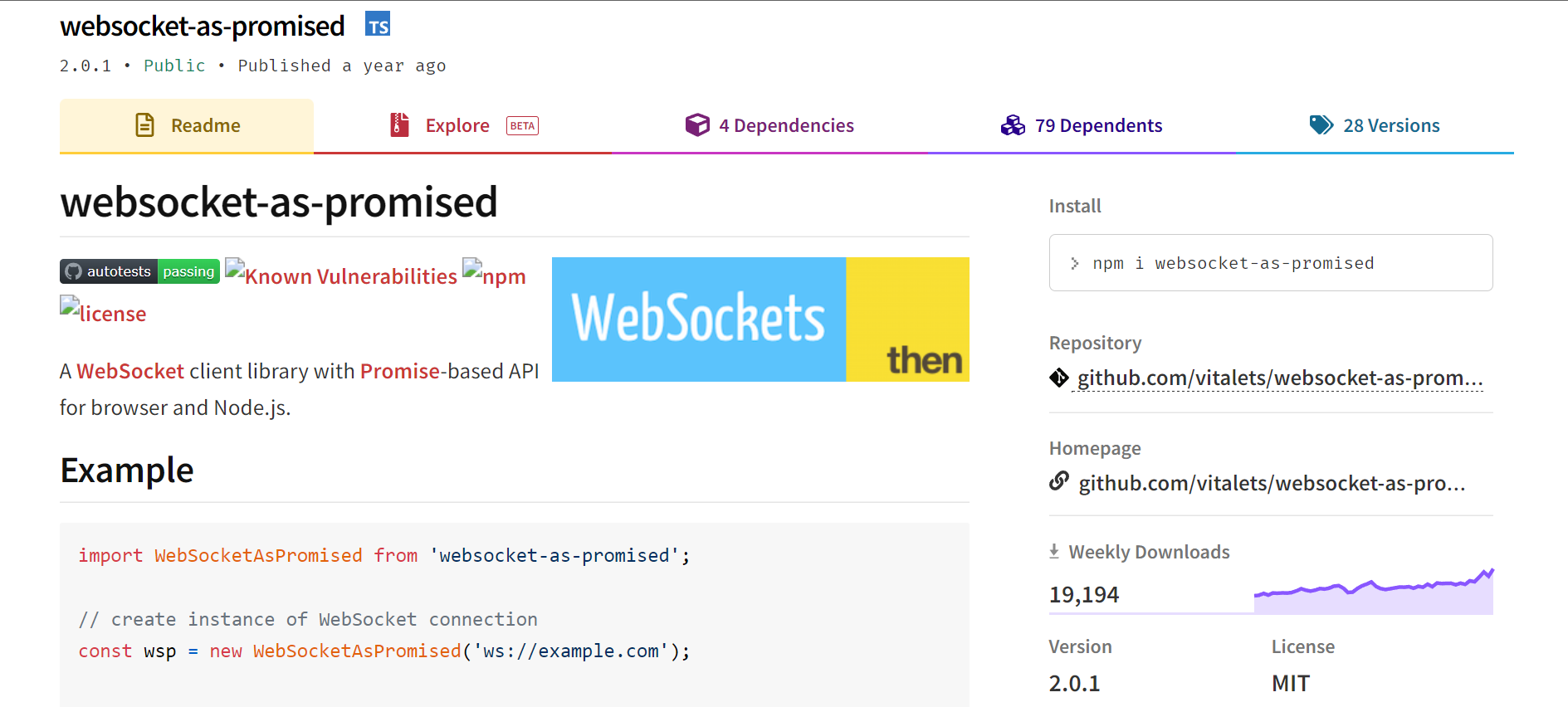
WebSocket As Promised is a WebSocket library that offers APIs for connection, disconnection, and messages with the server that are based on Promise. This approach essentially uses the request-response method and provides promises in return.
It needs to be used with third-party server node WebSocket libraries like WebSockets-node to function with Node.js. Even though it only has 200 stars, using it is still worthwhile. This project is still being developed.
Run the command below to install websocket-as-promised:
npm install --save websocket-as-promisedFinally!!!
In this article, we examined 9 WebSocket Libraries for Node.js, going over each one's features, popularity, and documentation. When developing Node.js applications in 2023, these libraries are the ones to keep an eye on.
Monitor Your Node.js Applications with Atatus
Atatus keeps track of your Node.js application to give you a complete picture of your clients' end-user experience. You can determine the source of delayed response times, database queries, and other issues by identifying backend performance bottlenecks for each API request.
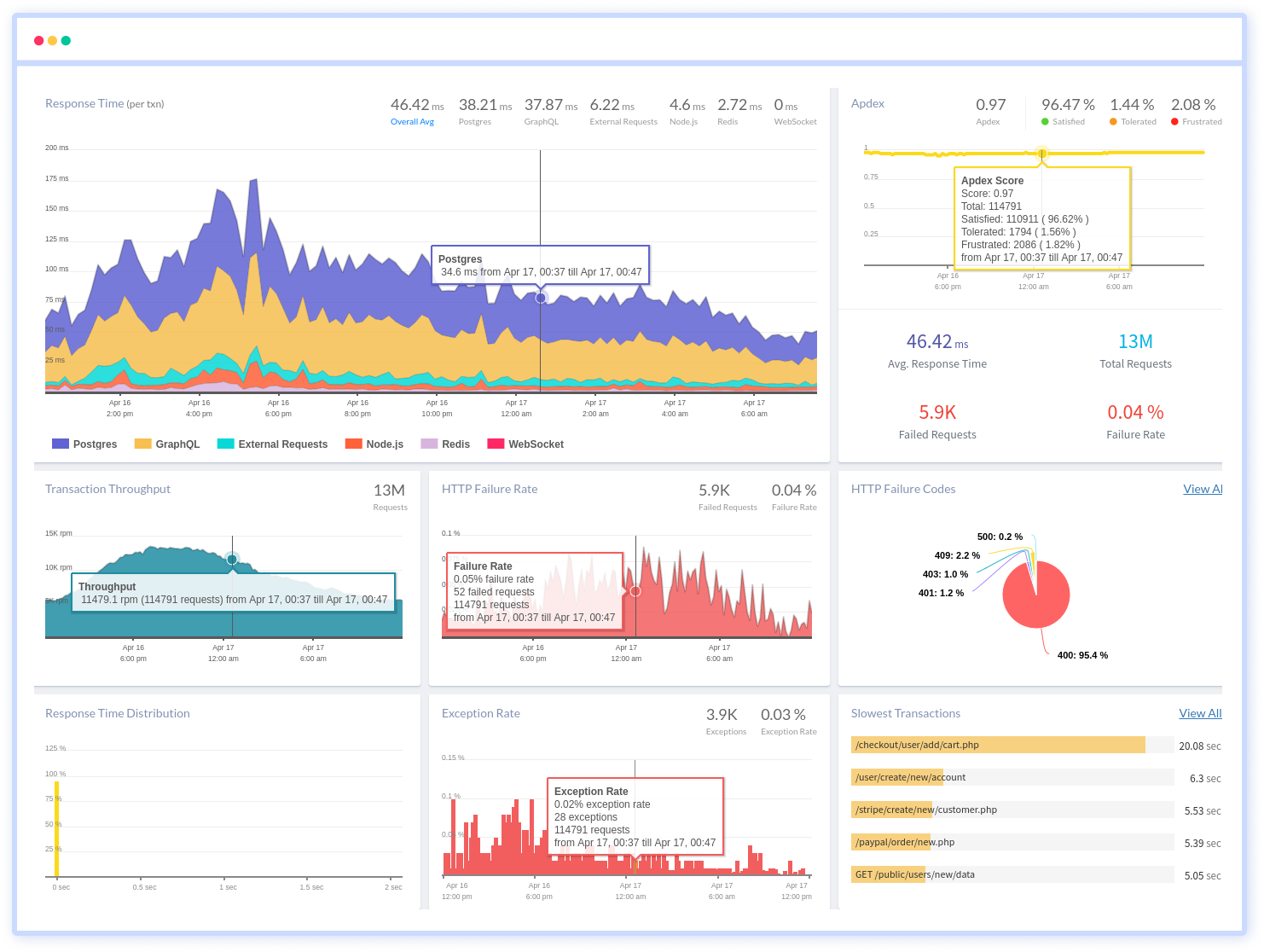
To make bug fixing easier, every Node.js error is captured with a full stack trace and the specific line of source code marked. To assist you in resolving the Node.js error, look at the user activities, console logs, and all Node.js requests that occurred at the moment. Error and exception alerts can be sent by email, Slack, PagerDuty, or webhooks.
#1 Solution for Logs, Traces & Metrics
APM
Kubernetes
Logs
Synthetics
RUM
Serverless
Security
More





